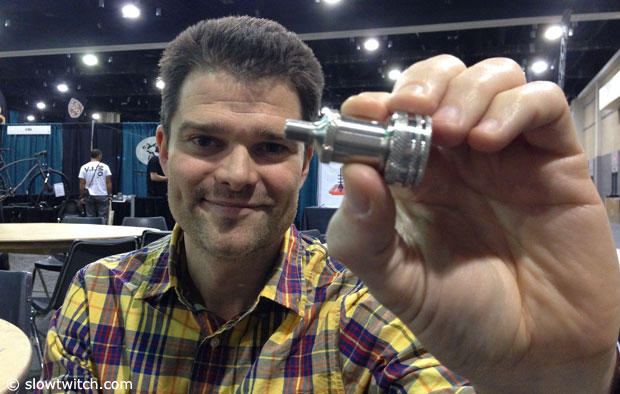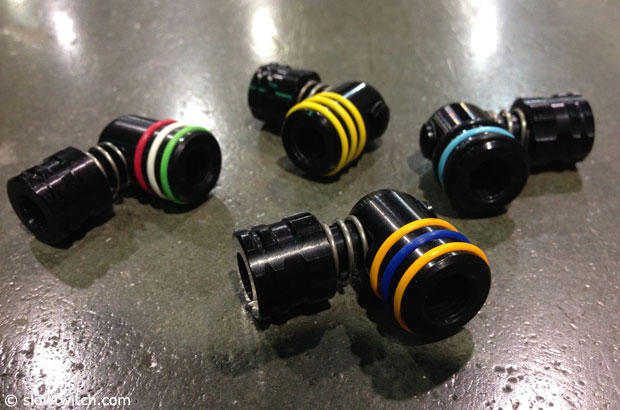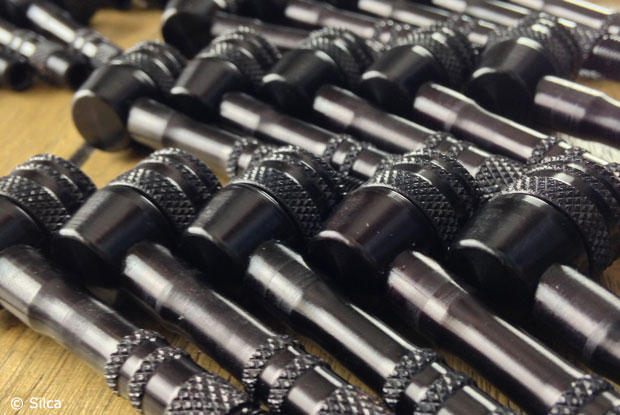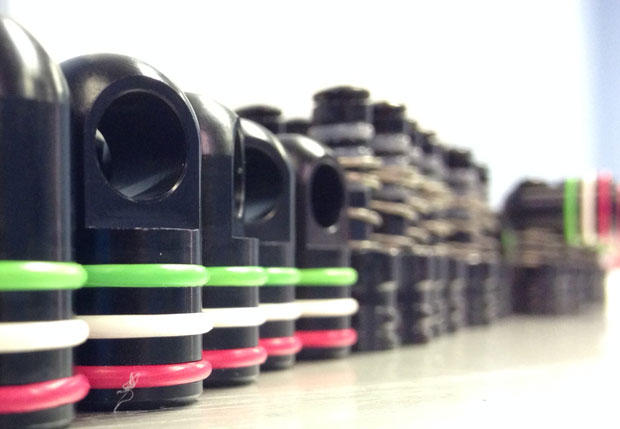The Silca man Josh Poertner
Josh Poertner is best known for his work at Zipp where he worked a long time and had his hands and mind on many projects including but not limited to the Firecrest wheel, but 8 months ago he left and invested into the venerable Silca brand. To be precise, Claudio Sacchi the grandson of the Silca founder contacted Poertner to see if he was interested in buying Silca – and interested he was indeed.
ST: Hi there Josh.
Josh: Hi there slowtwitch and Herbert! For the slowtwitch crowd, Herbert and I seem to be on every international flight for major trade shows for like 10 years! Taipei? Hi Herbert, I’m in the row in front of you! To Munich? Hi Herbert, I’m in the row across from you..etc.! Small world sometimes in the bike industry!
ST: True, very small world. But with folks now switching jobs more frequently, a flight is not such a good place to see which brand someone now works for. At least at a trade show you can check the name tag.
Josh: Totally true. I have more than once run into somebody at the airport or on a plane and introduced them to my colleagues as working for their previous company, or asked them how business was going at a company they no longer work for. After a while we become the faces of our brands and when things change it really messes up the order of things! Heck, 8 months on and I still say @zipp.com about half the time when I give out my email address to people!
ST: Does it feel like that time at Zipp was long ago or has time been flying by?
Josh: Feels like both an eternity and like a few minutes at the same time. With any product development type work, the time really flies, you try to work with daily, weekly and monthly deadlines and of course most of it gets blown up along the way! The reality on the ground is that every day is completely packed with must do activity and laying in bed at night all you can think about is all of the stuff that didn’t get done that day. I’ve taken to working something like 8-5, trying to make the most of dinner with my family and then back to work from 8pm-midnight. For the first 6-months or so, it was just me, so every day was really broken into blocks, of design, engineering, working with suppliers, assembly, manufacturing, accounting, sales, email, etc., so some days feel really long, yet on the whole they fly past.

ST: By now you have a few products in hand that people can buy. But it wasn’t a pump that was first offered.
Josh: No, I started early on the pump, but it was not even close to the first product to market. While SILCA has 96 years of amazing history, it internally had all of that history kept in spiral notebooks, and in Italian. So while my first thought was that I could ‘update’ the pump and get to market quickly, I soon realized that it was best to completely re-design all of the produce from scratch as details like engineering drawings, tolerances, process diagrams and descriptions, etc, would all have to be created from scratch anyway. What has happened is that my desire to completely re-think the entire pump category sort of overlapped my desire to quickly re-create the existing SILCA product and here we are still not to market with the floor pump, but close!
It’s amazing as I look at this category to think just how complex a pump is, yet how undervalued the entire category is. A good floor pump will have as many subcomponents as a high end hub, yet cost a fraction as much. Some of my early drawings for the main tube and piston rod were being no-quoted or coming in unbelievably expensive and one of our US vendors pointed out that these two components were specified at a higher precision than a high-end seatpost or handlebar, and yet were only 2 of some 40+ subcomponents of the pump. It became clear early on that doing pumps at the level I intended was really going to be much more of a project than anybody imagined, including me!
ST: The project disc wheel adapter however is a reality now, and word has it that Zipp will spec it with their disc wheels..
Josh: Yes. I am really proud of the disc wheel inflation adapter. I tell a humorous story about how I got to Zipp in 1999, valve extensions and disc inflation were the #1 and #3 most frequent customer service phone call topics and that when I left 14 years later they were #2 and #5. In In the first 60 days after buying SILCA, I was able to identify a highly tenacious elastomer from the oil and gas drilling industry, and design a new gasket using this material that sealed in 2 places on the valve stem vs 1 in most designs. The metal pieces were re-designed for production on Swiss machines, Citizen L20X for the machine shop junkies, and with that I was able to put a 15 degree angle in the stem to reduce stress on the valve, tighten tolerances, and even develop a geometry that allows the user to compensate for gasket wear by simply tightening the cap. All of it is US made within about 10 minutes of my house so at first I literally would email them the part geometry and then ride my bike over and test the parts as they came off of the machines. After 7 or 8 iterations, I took it to Zipp and said, ‘look, it’s more expensive, but it just works’ and they took it to the test lab an immediately found that it could take more than 2x the pressure of any other disc adapter without having to hold it in place. The part shipping with Zipp wheels today will do 150psi+ on most any valve stem without having to hold it in place, and discussion/questions about disc wheel inflation have already fallen off dramatically.
ST: It is pretty simplistic to think that coming from a hi-tech racing brand you might get bored with a simple classic durable pump business. But it isn’t so simple is it?
Josh: I think there are two parts to that question. One, everything high-tech, is probably pretty surprisingly low-tech in the development. Most of what I loved doing at Zipp was very hands on process of dreaming, designing, prototyping, testing, tooling, etc until we had something producible that worked. The only high-tech in my day to day was feeding the CFD system we had built, but in all honesty, there was such a high level of automation there, that as long as we came up with ideas, the software could run it and every day or so I would parse the data, which can be interesting, but generally isn’t all that exciting. While everybody wants to sort of think that an idea like Firecrest was some flash of high-tech genius, the reality is that it was one of many ideas that had to be vetted and refined across many variables and even once you have the idea in place, you then have to actually tool it and make the thing. I’ve always called this ‘90% there, 90% to go’ which serves as a nice reminder that actually making real things is hard. In many ways, what I’m doing now is much more like the early Zipp, its about refining ideas into concepts, and those concepts into prototypes, many made on small lathes or equipment in our shop and then using and refining the prototypes to get to the next level.

In many ways, it’s been really exciting as I’m getting to use materials that are very special and beautiful to me like wood and stainless steel. I love carbon fiber, and I love working with it both as a designer and a fabricator, but in many ways what I’m doing now is like going back to using real books after only being allowed to use ebooks. In many ways crossing the between the two worlds makes both experiences seem all the more rich and really improves the appreciation for both.
There is also real freedom and excitement in doing something completely different and new. Much of what made Zipp so successful was taking all of the people with significant bicycle racing and motor-racing experience and having them develop bicycle wheel solutions. A similar affect is in play here, as I am not out to design bicycle pumps and inflation, I’m out to design and create solutions for problems, and then use the resources available in motorsports and industry to solve those problems, it’s a very different way of looking at the world.
ST: What has been the most difficult element of that recent journey?
Josh: Patience! I explain it like trying to sprint in place. There is such a crazy urgency in a startup company, such a desire, and outright need to get product to market quickly so you stop bleeding money, while at the same time, you need everything to be right. The balance of urgency and reality is hard to find sometimes.
ST: Are you patient in general?
Josh: It really depends on the situation I guess. I think I’m very patient with learning and creativity as that takes time and the attitude you take really does affect the outcome. With some things in business, however, patience is much more difficult, and the real key is in finding productive ways to move the ball forward rather than just losing your cool. There really is a fine line between pushing too hard and being a counterproductive jerk and not pushing hard enough and letting things begin to slide off schedule.
ST: Is it appropriate to compare your investment in Silca to a very cool independent bookshop bought by a very passionate and smart bookworm?
Josh: I love the connotation of that analogy! I’m a huge bookstore fan and near constant reader, so I love where you’ve gone with that. However, the more apt comparison is much more on the lines of a family run auto racing team like Andretti Motorsports here in Indy. We definitely have a history to curate, and historical products to support, which is something Claudio felt so strongly about, and something I promised I would maintain. However, the day-to-day operations are much more about creating and building the new, rather than maintaining the old. So we’re like a tiny race shop, design up front, fabrication and assembly in the back.

ST: Along those lines, when will the new Silca pump be available?
Josh: We are on target now for July, which is much longer than I had anticipated or planned, but once I had the company, it became clear that the pump needed to be entirely new. This means that not only has there been a complete and total redesign of each component, but also the establishment of an entirely new supplier base. We are now complete through 3 rounds of prototypes locked on most all of our production level parts and tooling.
ST: What else is on your development schedule?
Josh: I have an entire list of problems that need to be solved! We’ve successfully gotten a handful of accessory products to market in the last few months and are having really great success with the disc wheel adapters and EOLO CO2 inflators which have been really well received by the media as well as customers. Next up for release in early June is a pretty slick valve extension, which I’m hopeful will become the new go-to solution for Slowtwitchers as it solves the problems that people have had with extensions since the beginning of time.
ST: We are glad that you still have a bit of time to post in the forum here and there. Or are some posts just too inviting to ignore?
Josh: Well, I don’t usually have time to scan the forum, but I have a whole host or people who email me links to probably a few times a day, to issues they think I should have some input on. Some of them definitely are hard to ignore! More than a few times I’ve typed things up and then thought that maybe I really shouldn’t tell that story for some reason or another.
ST: Do you shave your eyebrows or chest hair?
Josh: I don’t even shave my face most days! Back in my racing days I was a die-hard leg shaver who thought he would never quit, but time has proven even that to be untrue! Like you, I have two young kids, so pretty much every waking moment of my day is focused on SILCA or on my family, and if I have 10 extra minutes, then I read a book.
ST: Is there anything else we should know?
Josh: I’d like to tell the ST community just how much they shape the face of product for triathlon, at least from the perspective of American companies. I’ve been in many discussions with product managers, engineers, designers, and company owners from all the name brand companies you can think of and found that ST topics come up more than you might think. From the perspective on the industry, the forum is a great place to get a read on the issues that triathletes have, or in many cases, is a good place to get a read on the reception of ideas as new products come to market.





